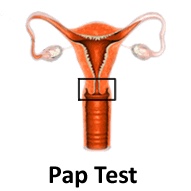The human papillomavirus (HPV) is the major cause of cervical cancer. Screening for infection with HPV is a way of identifying those women who might be at higer risk for developing cervical cancer.1, 2
The HPV DNA test is used in conjunction with the Pap test in cervical cancer screening. It is recommended for women over the age of 30 to reduce the need for Pap tests.
How it works: A Pap test can detect visible cellular abnormalities. The HPV DNA test can detect the presence of high risk HPV DNA. An HPV test uses the same method as a Pap test to obtain a cervical sample, but a different test is run on the cells that can determine whether or not high-risk HPV infection is present. As with any medical test, the HPV test is not 100% accurate The test uses a small brush or spatula to collect a sample of cells from the surface of the cervix, as in a Pap test. (see below). The test in not painful since the cells are taken only from the surface.1, 2
A study examining the effectiveness of the HPV DNA test in predicting the development of cervical abnormalities showed that it was better able to predict development of abnormalities than Pap tests. The authors do not suggest that Pap smears be discontinued and believe the tests should be used together.3


- 1ab Vince A, Lepej SZ. Diagnostic methods and techniques in cervical cancer prevention Part II: Molecular diagnostics of HPV infection. Med Glas Ljek komore Zenicko-doboj kantona. 2010 Feb;7(1):18-25. [PUBMED]
- 2ab Behtash N, Mehrdad N. Cervical cancer: screening and prevention. Asian Pac J Cancer Prev. 2006 Oct-Dec;7(4):683-6. [PUBMED]
- 3 Castle PE, Glass AG, Rush BB, Scott DR, Wentzensen N, Gage JC, Buckland J, Rydzak G, Lorincz AT, Wacholder S. Clinical Human Papillomavirus Detection Forecasts Cervical Cancer Risk in Women Over 18 Years of Follow-Up. J Clin Oncol. 2012 Jul 30. [Epub ahead of print] [PUBMED]
